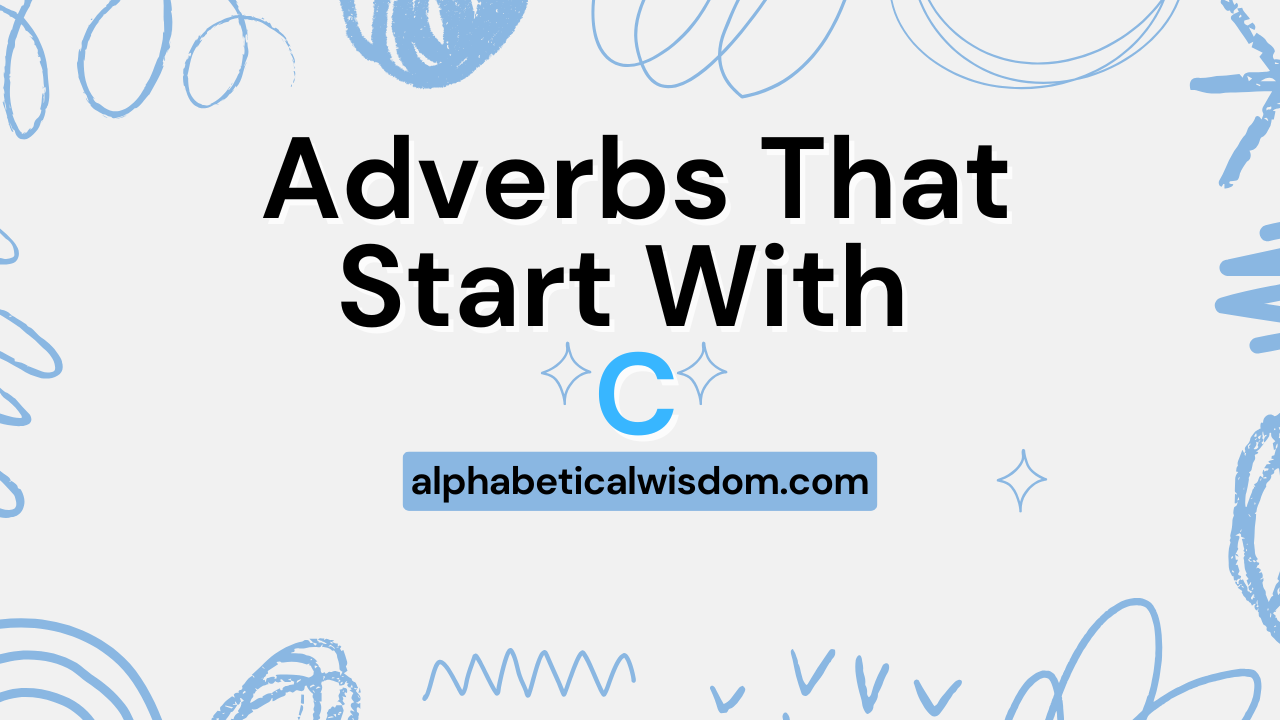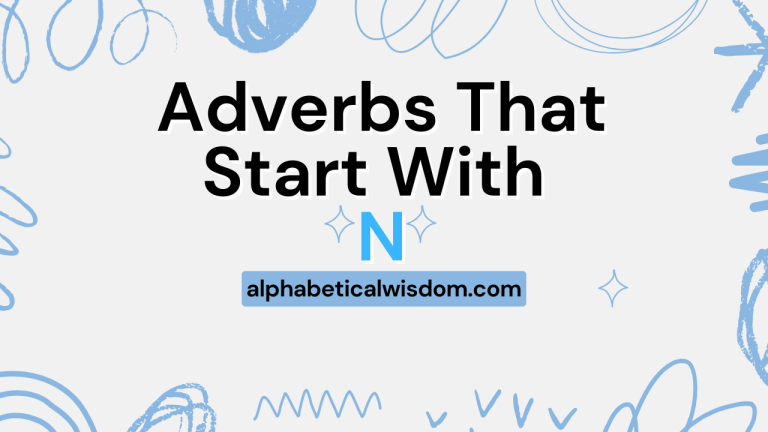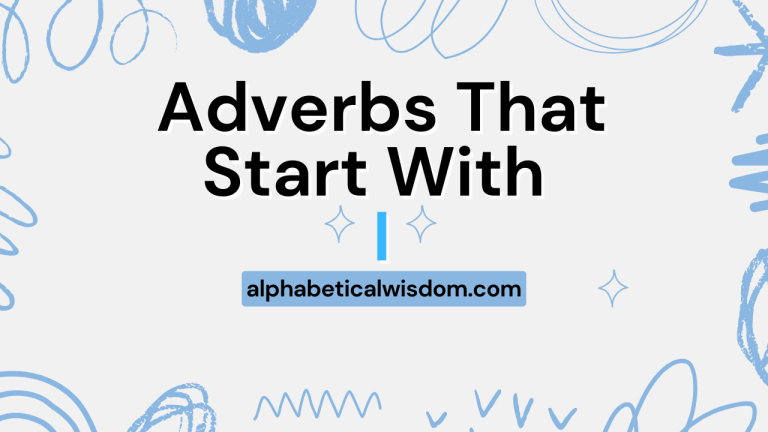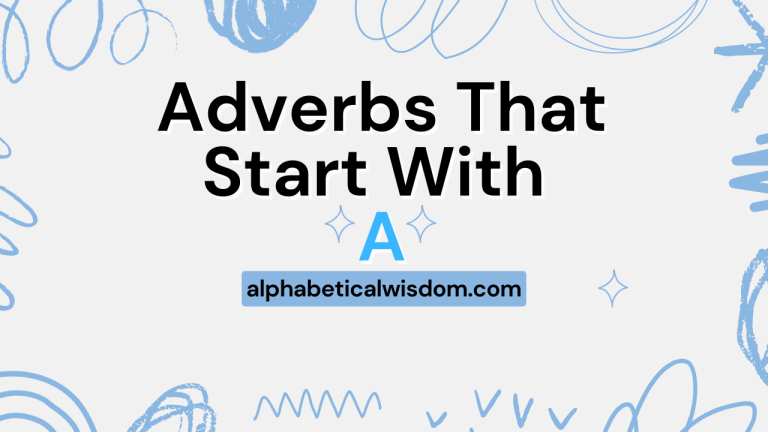Adverbs That Start With C: A Comprehensive Guide
Understanding adverbs is crucial for mastering English grammar. Adverbs modify verbs, adjectives, or other adverbs, providing essential details about how, when, where, or to what extent an action is performed or a quality is exhibited.
This article focuses specifically on adverbs that begin with the letter “C,” exploring their meanings, usage, and common pitfalls. Whether you are a beginner or an advanced learner, this guide will enhance your understanding and improve your ability to use “C” adverbs effectively.
This will give your writing and speaking more precision and clarity.
Table of Contents
- Introduction
- Definition of Adverbs
- Structural Breakdown of Adverbs
- Types of Adverbs Starting With C
- Examples of Adverbs Starting With C
- Usage Rules for Adverbs Starting With C
- Common Mistakes with Adverbs Starting With C
- Practice Exercises
- Advanced Topics
- FAQ
- Conclusion
Definition of Adverbs
An adverb is a word that modifies a verb, an adjective, another adverb, a phrase, or a clause. Adverbs provide additional information about how, when, where, why, or to what extent something is done or happens. They add detail and precision to sentences, making them more descriptive and informative. Understanding adverbs is essential for effective communication in English.
Adverbs are classified based on their function. Some common categories include adverbs of manner (how), adverbs of time (when), adverbs of place (where), adverbs of degree (to what extent), and adverbs of frequency (how often).
Each type plays a distinct role in conveying meaning.
The context in which an adverb is used significantly affects its meaning and impact. The same adverb can have different nuances depending on the surrounding words and the overall sentence structure.
Therefore, it is crucial to consider the context when interpreting and using adverbs.
Structural Breakdown of Adverbs
Adverbs can be single words (e.g., carefully, certainly), phrases (e.g., in a careful manner, without a doubt), or clauses (e.g., when the time is right, as quickly as possible). Single-word adverbs are the most common and often end in “-ly,” but many exceptions exist. Adverbial phrases consist of a preposition and a noun phrase, while adverbial clauses contain a subject and a verb.
The position of an adverb in a sentence can affect its meaning and emphasis. Adverbs can appear at the beginning, middle, or end of a sentence.
Fronting an adverb (placing it at the beginning) often adds emphasis. The choice of position depends on the intended effect and the flow of the sentence.
Many adverbs are formed by adding the suffix “-ly” to an adjective (e.g., quick becomes quickly, careful becomes carefully). However, some words that end in “-ly” are adjectives (e.g., friendly, lovely). It’s important to distinguish between adverbs and adjectives based on their function in the sentence.
Types of Adverbs Starting With C
Adverbs of Manner
Adverbs of manner describe how an action is performed. They often modify verbs and provide details about the way something is done. Examples include carefully, cautiously, and cheerfully.
Adverbs of Degree
Adverbs of degree indicate the intensity or extent of an action, quality, or state. They modify verbs, adjectives, or other adverbs. Examples include completely, considerably, and certainly.
Adverbs of Time
Adverbs of time specify when an action occurs. They provide information about the timing of an event. Examples include currently and continuously.
Adverbs of Frequency
Adverbs of frequency describe how often an action happens. While fewer adverbs of frequency start with “C,” understanding this category is helpful for overall adverb usage. Examples include constantly and customarily.
Adverbs of Place
Adverbs of place indicate where an action takes place. These adverbs, while less common starting with “C,” still contribute to descriptive language. Examples include close (used adverbially, as in “stay close”) and center (used adverbially, as in “place it center”).
Examples of Adverbs Starting With C
Adverbs of Manner Examples
The following table provides examples of adverbs of manner that begin with the letter “C,” illustrating how they modify verbs to describe the manner in which an action is performed.
| Adverb | Example Sentence |
|---|---|
| Carefully | She carefully placed the vase on the table. |
| Cautiously | The hikers cautiously crossed the slippery bridge. |
| Cheerfully | He cheerfully greeted his colleagues every morning. |
| Calmly | The pilot calmly announced the emergency landing. |
| Cleverly | The detective cleverly solved the mystery. |
| Clearly | She clearly explained the instructions. |
| Closely | The security guard closely monitored the surveillance cameras. |
| Comfortably | He sat comfortably in his favorite armchair. |
| Completely | The project was completely finished on time. |
| Confidently | She confidently delivered her presentation. |
| Consciously | He consciously avoided making eye contact. |
| Considerately | They considerately offered her a seat. |
| Constantly | The baby constantly cried throughout the night. |
| Correctly | He correctly answered all the questions on the test. |
| Courageously | The firefighter courageously entered the burning building. |
| Critically | The reviewer critically analyzed the film. |
| Cruelly | The bully cruelly taunted the smaller child. |
| Curiously | The cat curiously approached the strange object. |
| Customarily | He customarily drank tea in the morning. |
| Crazily | The fans cheered crazily when their team won. |
| Casually | He casually mentioned his promotion. |
| Coyly | She coyly smiled at him. |
| Compactly | The items were compactly arranged in the box. |
| Compassionately | The nurse compassionately cared for the patients. |
| Competitively | The athletes competitively raced to the finish line. |
Adverbs of Degree Examples
Adverbs of degree modify the intensity or extent of an action or quality. Here are some examples of adverbs of degree starting with “C.”
| Adverb | Example Sentence |
|---|---|
| Completely | I am completely satisfied with the service. |
| Considerably | The price has increased considerably in recent months. |
| Certainly | He is certainly a talented musician. |
| Chiefly | The problem was chiefly caused by a lack of communication. |
| Close | He stood close to the stage. |
| Comparatively | The new model is comparatively better than the old one. |
| Conclusively | The evidence conclusively proved his innocence. |
| Curiously | Curiously enough, no one seemed to notice. |
| Convincingly | He argued his point convincingly. |
| Captivatingly | She sang captivatingly, holding the audience spellbound. |
| Characteristically | He responded characteristically with a witty remark. |
| Classically | The song was classically arranged. |
| Collectively | The team worked collectively to achieve their goal. |
| Colorfully | The garden was colorfully decorated. |
| Comfortably | The room was comfortably warm. |
| Commonly | This species is commonly found in this area. |
| Communicatively | He expressed himself communicatively. |
| Compactly | The data was stored compactly. |
| Comparably | The two products are comparably priced. |
| Compatibly | The software runs compatibly with the new operating system. |
| Compellingly | The evidence was compellingly presented. |
| Competently | He handled the situation competently. |
| Complainingly | He complainingly did the chores. |
| Complexly | The issue was complexly interwoven with other factors. |
| Comprehensibly | The instructions were written comprehensibly. |
Adverbs of Time Examples
Adverbs of time specify when an action takes place. They add temporal context to the sentence.
Here are some examples of adverbs of time starting with “C.”
| Adverb | Example Sentence |
|---|---|
| Currently | She is currently working on her thesis. |
| Continuously | The rain fell continuously throughout the day. |
| Chronologically | The events are listed chronologically. |
| Coincidentally | Coincidentally, we were both at the same event. |
| Consequently | He failed to study; consequently, he failed the exam. |
| Centrally | The meeting will be held centrally to accommodate everyone. |
| Circumstantially | The case was built circumstantially. |
| Cyclically | The seasons change cyclically. |
| Contemporaneously | The two events happened contemporaneously. |
| Ceaselessly | The wind blew ceaselessly throughout the night. |
| Confidently | Confidently, he predicted a positive outcome. |
| Conjecturally | The theory was proposed conjecturally. |
| Consistently | The team performed consistently well. |
| Constitutionally | The law was challenged constitutionally. |
| Contextually | The meaning changes contextually. |
| Contractually | He is contractually obligated to complete the project. |
| Conversely | Conversely, the opposite is also true. |
| Corporately | The company is managed corporately. |
| Correctively | The issue was addressed correctively. |
| Correspondingly | As prices rise, demand decreases correspondingly. |
| Creatively | The problem was solved creatively. |
| Credibly | He testified credibly. |
| Criminally | He was charged criminally. |
| Cumulatively | The effects add up cumulatively. |
| Culturally | The traditions vary culturally. |
Adverbs of Frequency Examples
Adverbs of frequency indicate how often an action occurs. They provide information about the regularity of an event.
Here are some examples that start with “C.”
| Adverb | Example Sentence |
|---|---|
| Constantly | He constantly checks his phone. |
| Customarily | She customarily drinks tea in the morning. |
| Continually | The machine continually produced errors. |
| Chronically | He is chronically late for appointments. |
| Consecutively | The team won five games consecutively. |
Usage Rules for Adverbs Starting With C
Adverbs modify verbs, adjectives, or other adverbs. When modifying a verb, the adverb typically appears before or after the verb, depending on the style and emphasis desired.
For example: “She carefully painted the portrait” or “She painted the portrait carefully.”
When modifying an adjective or another adverb, the adverb usually precedes the word it modifies. For example: “He is certainly a talented musician” (modifying the adjective “talented”) or “She ran incredibly quickly” (modifying the adverb “quickly”).
Some adverbs can modify entire sentences, providing context or expressing an opinion. These adverbs often appear at the beginning of the sentence, followed by a comma.
For example: “Certainly, I will help you with that” or “Consequently, the project was delayed.”
Be mindful of the placement of adverbs to avoid ambiguity. Placing an adverb in the wrong position can change the meaning of the sentence.
For example, “Only she smiled” implies that no one else smiled, while “She only smiled” implies that she did nothing else but smile.
Some adverbs have different forms depending on their function. For example, “close” can be an adjective (e.g., “a close friend”) or an adverb (e.g., “stay close”).
Pay attention to the context to determine the correct form to use.
Use adverbs sparingly to avoid cluttering your writing. Choose strong verbs and precise nouns whenever possible to convey your meaning effectively without relying too heavily on adverbs.
Overuse of adverbs can make your writing sound weak or repetitive.
Common Mistakes with Adverbs Starting With C
One common mistake is confusing adverbs with adjectives. Remember that adverbs modify verbs, adjectives, or other adverbs, while adjectives modify nouns.
For example, it’s incorrect to say “He is a carefully driver”; the correct sentence is “He is a careful driver” (adjective) or “He drives carefully” (adverb).
Another frequent error is misplacing adverbs in a sentence, which can lead to ambiguity or unintended meanings. For example, “I only ate an apple” implies that I ate nothing else, while “I ate only an apple” implies that I ate just one apple.
Pay attention to the placement of the adverb to ensure that your meaning is clear.
Overusing adverbs is a common pitfall. While adverbs can add detail and precision to your writing, too many adverbs can make your writing sound weak or repetitive.
Choose strong verbs and precise nouns whenever possible to convey your meaning effectively without relying too heavily on adverbs.
Using adverbs incorrectly with linking verbs is another common mistake. Linking verbs (e.g., be, seem, become) connect the subject of a sentence to a noun or adjective that describes the subject. With linking verbs, use adjectives to describe the subject, not adverbs. For example, it’s incorrect to say “He felt badly”; the correct sentence is “He felt bad.”
Confusing the adverbs ‘close’ and ‘closely’ is a common error. ‘Close’ as an adverb means ‘near’, while ‘closely’ means ‘attentively’ or ‘carefully’.
For example, “Stay close to me” (near) vs. “Watch closely” (attentively).
Here’s a table of common mistakes and corrections:
| Incorrect | Correct | Explanation |
|---|---|---|
| He is a carefully driver. | He is a careful driver. / He drives carefully. | Adjective vs. Adverb |
| I only ate an apple. | I ate only an apple. | Misplaced adverb |
| He felt badly. | He felt bad. | Adjective with linking verb |
| Stay closely to me. | Stay close to me. | Close vs. Closely |
| She completely agreed. | She agreed completely. | Adverb placement for emphasis. |
Practice Exercises
Exercise 1: Identifying Adverbs
Identify the adverbs in the following sentences.
| Question | Answer |
|---|---|
| 1. She carefully painted the portrait. | Carefully |
| 2. He certainly is a talented musician. | Certainly |
| 3. The rain fell continuously throughout the day. | Continuously |
| 4. He constantly checks his phone. | Constantly |
| 5. The hikers cautiously crossed the slippery bridge. | Cautiously |
| 6. She clearly explained the instructions. | Clearly |
| 7. They considerately offered her a seat. | Considerately |
| 8. The reviewer critically analyzed the film. | Critically |
| 9. I am completely satisfied with the service. | Completely |
| 10. The price has increased considerably in recent months. | Considerably |
Exercise 2: Using Adverbs in Sentences
Fill in the blanks with an appropriate adverb starting with “C.”
| Question | Answer |
|---|---|
| 1. He spoke __________ about his experiences. | Confidently |
| 2. The items were arranged __________ in the box. | Compactly |
| 3. She __________ denied the allegations. | Categorically |
| 4. The two events happened __________. | Coincidentally |
| 5. He is __________ late for appointments. | Chronically |
| 6. The problem was solved __________. | Creatively |
| 7. The nurse __________ cared for the patients. | Compassionately |
| 8. The team performed __________ well. | Consistently |
| 9. She __________ smiled at him. | Coyly |
| 10. The evidence proved his innocence __________. | Conclusively |
Exercise 3: Correcting Sentences
Correct the sentences below that contain errors in adverb usage.
| Question | Answer |
|---|---|
| 1. He is a carefully driver. | He drives carefully. |
| 2. Stay closely to me. | Stay close to me. |
| 3. She completely agreed with the decision. | She agreed completely with the decision. (Emphasis can vary) |
| 4. He felt badly about the mistake. | He felt bad about the mistake. |
| 5. The task was complete finished. | The task was completely finished. |
| 6. They lived comfortly in their new home. | They lived comfortably in their new home. |
| 7. He answered the question correct. | He answered the question correctly. |
| 8. She spoke clear and concise. | She spoke clearly and concisely. |
| 9. The children played happy outside. | The children played happily outside. |
| 10. He only studied a little. | He studied only a little. |
Advanced Topics
Adverbial Clauses: Adverbial clauses are dependent clauses that function as adverbs, modifying verbs, adjectives, or other adverbs in the main clause. They begin with subordinating conjunctions such as because, although, if, when, and where. For example: “I will help you if you need it” (adverbial clause of condition).
Conjunct Adverbs: Conjunct adverbs (also known as adverbial conjunctions) connect two independent clauses, indicating the relationship between them. Examples include however, therefore, moreover, consequently, and nevertheless. For example: “He failed to study; consequently, he failed the exam.”
Flat Adverbs: Flat adverbs are adverbs that have the same form as their corresponding adjectives (e.g., fast, hard, early). While many adverbs end in “-ly,” flat adverbs do not. For example: “He runs fast” (fast is an adverb) vs. “He is a fast runner” (fast is an adjective).
Scope of Adverbs: The scope of an adverb refers to the part of the sentence that the adverb modifies. Understanding the scope of an adverb is crucial for interpreting the meaning of the sentence correctly. The position of the adverb often determines its scope. For example, in the sentence “He only ate an apple,” the scope of “only” is “ate,” indicating that he did nothing else but eat the apple.
FAQ
- What is the difference between an adverb and an adjective?
Adverbs modify verbs, adjectives, or other adverbs, providing information about how, when, where, why, or to what extent something is done or happens. Adjectives, on the other hand, modify nouns or pronouns, describing their qualities or characteristics. For example, “He runs quickly” (adverb) vs. “He is a quick runner” (adjective).
- How can I identify an adverb in a sentence?
Look for words that modify verbs, adjectives, or other adverbs. Adverbs often answer questions like how, when, where, why, or to what extent. Many adverbs end in “-ly,” but not all words ending in “-ly” are adverbs (e.g., friendly is an adjective). Consider the function of the word in the sentence.
- Where should I place an adverb in a sentence?
The placement of an adverb depends on the type of adverb and the emphasis you want to convey. Adverbs of manner often appear after the verb or after the object of the verb. Adverbs of frequency usually appear before the main verb (except for the verb to be, where they appear after). Adverbs that modify entire sentences typically appear at the beginning of the sentence.
- Can an adverb modify a noun?
No, adverbs do not modify nouns. Nouns are modified by adjectives. If you need to describe a noun, use an adjective instead of an adverb.
- What are some common adverbs that do not end in “-ly”?
Some common adverbs that do not end in “-ly” include fast, hard, early, well, often, never, always, here, and there. These adverbs are often referred to as flat adverbs.
- How do I avoid overusing adverbs in my writing?
Choose strong verbs and precise nouns whenever possible to convey your meaning effectively without relying too heavily on adverbs. Instead of saying “He ran very quickly,” try “He sprinted.” Review your writing and eliminate unnecessary adverbs that do not add significant meaning.
- What is a conjunct adverb, and how is it used?
A conjunct adverb (also known as an adverbial conjunction) connects two independent clauses, indicating the relationship between them. Common conjunct adverbs include however, therefore, moreover, consequently, and nevertheless. Use a semicolon before the conjunct adverb and a comma after it. For example: “He failed to study; consequently, he failed the exam.”
- How do I use adverbs of frequency correctly?
Adverbs of frequency (e.g., always, usually, often, sometimes, never) indicate how often an action occurs. They typically appear before the main verb (except for the verb to be, where they appear after). For example: “I always drink coffee in the morning” or “He is never late.”
- Can I start a sentence with an adverb?
Yes, you can start a sentence with an adverb. This is often done to add emphasis or to connect the sentence to the previous one. For example: “Certainly, I will help you with that” or “Consequently, the project was delayed.” When starting a sentence with an adverb, use a comma after the adverb.
- What is the difference between ‘good’ and ‘well’?
‘Good’ is an adjective, while ‘well’ is an adverb. ‘Good’ modifies nouns, while ‘well’ modifies verbs, adjectives, or other adverbs. For example, “He is a good student” (adjective) vs. “He plays the piano well” (adverb). However, ‘well’ can also be an adjective meaning ‘in good health’. For example, “I am well, thank you.”
Conclusion
Adverbs are essential components of the English language, adding depth and precision to our communication. By focusing on adverbs that start with the letter “C,” this guide has provided a targeted approach to enhancing your understanding and usage of these versatile words.
Remember to pay attention to the different types of adverbs, their placement in sentences, and common mistakes to avoid. With practice and careful attention, you can effectively incorporate “C” adverbs into your writing and speech, making your language more descriptive and impactful.
Mastering adverbs is a continuous process. Continue to practice using adverbs in different contexts, and pay attention to how native speakers use them.
Read widely and listen attentively to improve your understanding and usage of adverbs. With consistent effort, you can become proficient in using adverbs effectively and confidently.
The key is to keep learning, practicing, and refining your skills.






